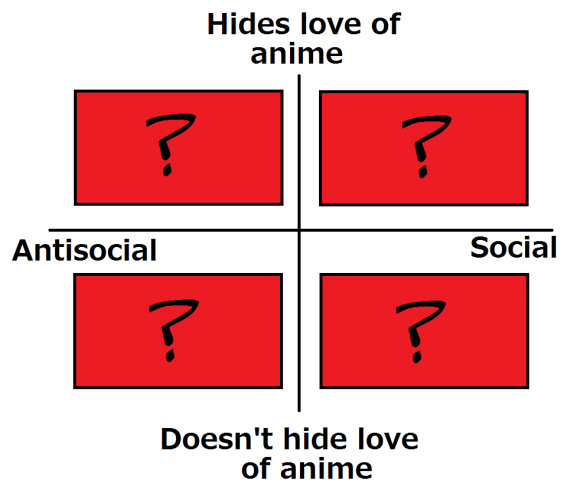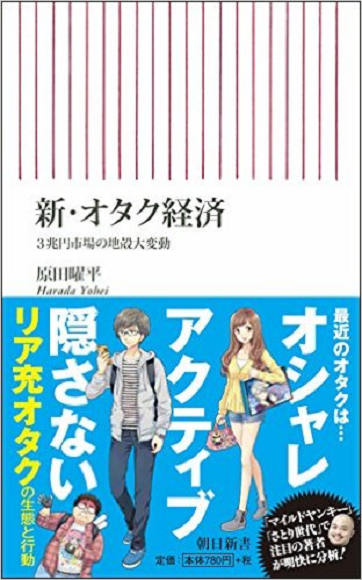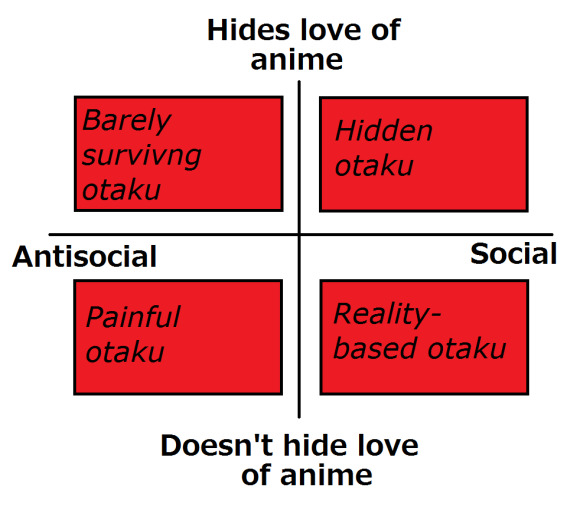
Which otaku quadrant do you fall into?
At some point, Japanese society needed a way to refer to its members who were extremely passionate about anime. Eventually, “otaku” was decided on, and the word has filled its role nicely for the past few decades.
But as popular culture continues to evolve, so too must language. Enthusiastic anime fandom now takes on many forms beyond the loner who isolates himself from the rest of the world as he spends every spare moment quietly consuming anime. That’s why marketing analyst Yohei Harada says it’s more accurate to think of Japanese animation fanatics as one of four classes of modern otaku.
In his new book, Shin Otaku Keizai (“New Otaku Economics”), Harada uses two parameters to divide the groups of new otaku, or “shin otaku” to use the completely Japanese term.
▼ Cover of Shin Otaku Keizai
Let’s take a look at the breakdown.
1. The barely surviving otaku (zanson gachiotaku)
This group represents what Harada considers to be the gradually disappearing, stereotypical otaku: someone whose deep love for anime is a result or cause of social isolation (or perhaps both), and who keeps his intense appreciation of the medium on the down-low. While there are still some people who fit this description, Harada asserts that many members of this demographic are evolving into one of the other three .
2. The hidden otaku (kakure otaku)
While he loves anime, the hidden otaku doesn’t wear his fandom on his sleeve, and keeps his otaku leanings and active social life as separate aspects of his identity.
3. The painful otaku (itaota)
Like the anime character-emblazoned cars called itasha, the itaota designation is derived from the Japanese word itai, or “painful,” implying that they’re somewhat painful to look at. The painful otaku isn’t shy about trumpeting his otaku-ness, but isn’t particularly inclined to participate in social interactions either. The guy or girl who trudges silently around Akihabara every weekend, with their only company the dozens of pins of their favorite anime character that they’ve attached to their bag, seems like someone who would fall into this group.
4. The reality-based otaku (riaju otaku)
Ria ju, literally “real type,” was originally a word coined by otaku in Japan to describe what they saw as their polar opposite: people who spent most of their free time interacting with other people, instead of focusing on the lives and stories of fictional characters. But Harada explains that nowadays, plenty of people are happy to spend time with both their 2-D and real-world friends.
As a matter of fact, Harada says that some of them make a point of being open with their otaku tastes, especially in their online personas. Doing so helps them open up new lines of communication and broaden their social networks, which in turn feeds into their enjoyment of those human-to-human connections.
While the names of these four groups may not have quite the stylish impact of iconic anime organizations like the Shinigami, Sailor Senshi, or Newtypes, Harada’s analysis highlights the changing relationship Japan has with its own works of animation, as well as why “nerd” doesn’t quote cover all the bases as a translation for “otaku.”
Special thanks to Rocketnews24 reader Carrot Glace for the tip!
Source: Confidence/Yahoo! News Japan, Oricon Biz Online
Top image: RocketNews24
Insert images: Amazon Japan, RocketNews24



 Matching geeky, otaku outfits are the latest in Japanese street fashion【Pics】
Matching geeky, otaku outfits are the latest in Japanese street fashion【Pics】 The pitfalls of inter-otaku conversation, turns out it’s no better than with non-otaku
The pitfalls of inter-otaku conversation, turns out it’s no better than with non-otaku Five reasons nerds make great boyfriends: Japan’s geeky otaku list their pros
Five reasons nerds make great boyfriends: Japan’s geeky otaku list their pros Tekken Project’s ‘Summer Lesson’ VR demo now has an English-speaking girl
Tekken Project’s ‘Summer Lesson’ VR demo now has an English-speaking girl Eight reasons otaku men are unpopular with women, according to Japanese Twitter list
Eight reasons otaku men are unpopular with women, according to Japanese Twitter list How to order snacks on a Shinkansen bullet train in Japan
How to order snacks on a Shinkansen bullet train in Japan Japan’s new difficult-to-drink-from beer glass protects your liver, but it’s a brutal experience
Japan’s new difficult-to-drink-from beer glass protects your liver, but it’s a brutal experience Burger King Japan suddenly adds Dr. Pepper and Dr. Pepper floats to its menu nationwide
Burger King Japan suddenly adds Dr. Pepper and Dr. Pepper floats to its menu nationwide Demon Slayer: Kimetsu no Yaiba gets new roller coaster attractions and food at Universal Studios Japan
Demon Slayer: Kimetsu no Yaiba gets new roller coaster attractions and food at Universal Studios Japan Hello, cosmetics! Clinique teams up with Hello Kitty this summer for first-time collaboration
Hello, cosmetics! Clinique teams up with Hello Kitty this summer for first-time collaboration Kyoto Tower mascot termination reveals dark side behind cute Japanese characters
Kyoto Tower mascot termination reveals dark side behind cute Japanese characters Nintendo history you can feel – Super NES, N64, and GameCube controllers become capsule toys
Nintendo history you can feel – Super NES, N64, and GameCube controllers become capsule toys This Nara workshop has been making deer crackers for more than 100 years and offers tours【Photos】
This Nara workshop has been making deer crackers for more than 100 years and offers tours【Photos】 High-fashion Totoro cuddle purse is like an elegant stroll in the forest【Photos】
High-fashion Totoro cuddle purse is like an elegant stroll in the forest【Photos】 Legendary Melon Bread by Tokyo Banana returns after 20-year absence【Taste Test】
Legendary Melon Bread by Tokyo Banana returns after 20-year absence【Taste Test】 “The most Delicious Cup Noodle in history” – Japan’s French Cup Noodle wins our heart【Taste test】
“The most Delicious Cup Noodle in history” – Japan’s French Cup Noodle wins our heart【Taste test】 Starbucks releases a cute Frappuccino and Unicorn Cake…but not in Japan
Starbucks releases a cute Frappuccino and Unicorn Cake…but not in Japan McDonald’s Japan’s Soft Twist Tower: A phantom ice cream only sold at select branches
McDonald’s Japan’s Soft Twist Tower: A phantom ice cream only sold at select branches Yabai Ramen: What makes this Japanese ramen so dangerous?
Yabai Ramen: What makes this Japanese ramen so dangerous? Finally! Nintendo Japan expands Switch 8-bit controller sales to everybody, Online member or not
Finally! Nintendo Japan expands Switch 8-bit controller sales to everybody, Online member or not Japanese government wants to build luxury resorts in all national parks for foreign tourists
Japanese government wants to build luxury resorts in all national parks for foreign tourists To combat declining birth rate, Japan to begin offering “Breeding Visas” to foreigners
To combat declining birth rate, Japan to begin offering “Breeding Visas” to foreigners 10 things you should buy at 7-Eleven in Japan
10 things you should buy at 7-Eleven in Japan Studio Ghibli releases anime heroine cosplay dresses that are super comfy to wear
Studio Ghibli releases anime heroine cosplay dresses that are super comfy to wear Woman charged for driving suitcase without a license in Osaka
Woman charged for driving suitcase without a license in Osaka Studio Ghibli unveils My Neighbour Totoro miniature house model
Studio Ghibli unveils My Neighbour Totoro miniature house model Kyoto experiencing problems with foreign tourists not paying for bus fares, but not on purpose
Kyoto experiencing problems with foreign tourists not paying for bus fares, but not on purpose Fighting mild hunger with a Japanese soda that turns into jelly in the stomach【Taste test】
Fighting mild hunger with a Japanese soda that turns into jelly in the stomach【Taste test】 Studio Ghibli’s Howl’s Moving Castle tapestry unveiled in Japan for first time
Studio Ghibli’s Howl’s Moving Castle tapestry unveiled in Japan for first time McDonald’s new Happy Meals offer up cute and practical Sanrio lifestyle goods
McDonald’s new Happy Meals offer up cute and practical Sanrio lifestyle goods Sales of Japan’s most convenient train ticket/shopping payment cards suspended indefinitely
Sales of Japan’s most convenient train ticket/shopping payment cards suspended indefinitely Sold-out Studio Ghibli desktop humidifiers are back so Totoro can help you through the dry season
Sold-out Studio Ghibli desktop humidifiers are back so Totoro can help you through the dry season Japanese government to make first change to romanization spelling rules since the 1950s
Japanese government to make first change to romanization spelling rules since the 1950s Foreigner’s request for help in Tokyo makes us sad for the state of society
Foreigner’s request for help in Tokyo makes us sad for the state of society Ghibli founders Toshio Suzuki and Hayao Miyazaki contribute to Japanese whisky Totoro label design
Ghibli founders Toshio Suzuki and Hayao Miyazaki contribute to Japanese whisky Totoro label design Doraemon found buried at sea as scene from 1993 anime becomes real life【Photos】
Doraemon found buried at sea as scene from 1993 anime becomes real life【Photos】 Tokyo’s most famous Starbucks is closed
Tokyo’s most famous Starbucks is closed Princesses, fruits, and blacksmiths: Study reveals the 30 most unusual family names in Japan
Princesses, fruits, and blacksmiths: Study reveals the 30 most unusual family names in Japan 10 signs you might not be an otaku anymore
10 signs you might not be an otaku anymore Tekken producer explains virtual reality girl demo ‘Summer Lesson’
Tekken producer explains virtual reality girl demo ‘Summer Lesson’ Could you marry an otaku? Japanese people rank the geek hobbies they’d let slide for love
Could you marry an otaku? Japanese people rank the geek hobbies they’d let slide for love Adult otaku reflects on why it’s now easier for Japanese anime fans to be open about their hobby
Adult otaku reflects on why it’s now easier for Japanese anime fans to be open about their hobby Otaku dating service advises singles to have interests other than anime
Otaku dating service advises singles to have interests other than anime Nearly 70 percent of young Japanese women self-identify as otaku in survey
Nearly 70 percent of young Japanese women self-identify as otaku in survey Anime song dance performance group Real Akiba Boys: combining the otaku life with street dancing
Anime song dance performance group Real Akiba Boys: combining the otaku life with street dancing Okonomiyaki you can eat with one hand? We try a revolutionary new frozen food【Taste test】
Okonomiyaki you can eat with one hand? We try a revolutionary new frozen food【Taste test】 Russian Roulette Bread: The frightening new treat at Japanese convenience stores【Taste test】
Russian Roulette Bread: The frightening new treat at Japanese convenience stores【Taste test】 The reason why the best spouse for an otaku might not be another otaku
The reason why the best spouse for an otaku might not be another otaku Seven reasons why an otaku should date another otaku (and one reason maybe not to)
Seven reasons why an otaku should date another otaku (and one reason maybe not to) Japanese women rank the otaku obsessions they can most forgive in a partner
Japanese women rank the otaku obsessions they can most forgive in a partner Aichi man arrested again after having slashed over 1,000 women’s tires to get to know them better
Aichi man arrested again after having slashed over 1,000 women’s tires to get to know them better
Leave a Reply